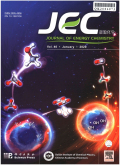- 钛学术文献服务平台 \
- 学术期刊 \
- 工业技术期刊 \
- 石油与天然气工业期刊 \
- 能源化学期刊 \
Ether-compatible lithium sulfur batteries with robust performance via selenium doping
Ether-compatible lithium sulfur batteries with robust performance via selenium doping
基本信息来源于合作网站,原文需代理用户跳转至来源网站获取
摘要:
The increasing demand of the green energy storage system en-courages us to develop a higher energy storage system to take the place of the present lithium-ion batteries with limited en-ergy/power densities [1,2]. Among the diverse candidates, lithium–sulfur (Li–S) batteries have received tremendous attention because of their attractive theoretical discharge capacity (1675 mAh g-1) and energy density (2600 Wh kg-1) which are 3–5 times than the state-of-the-art lithium-ion batteries [3,4]. Unfortunately, the ac-tual applications of Li–S batteries are still impeded by the seri-ously effect of polysulfides shuttle and slow reaction kinetics of the electrochemical reaction relying on a dissolution–precipitation mechanism. The intermediate lithium polysulfides (LiPSs) succes-sively assemble between anode and cathode and react with active lithium metal, causing gradual sulfur loss and low Coulombic ef-ficiency. Moreover, poor electrical and ionic conductivities of sul-fur specifies such as sulfur, LiPSs, and Li2S make it difficult for the proceeding of the redox reaction, especially considering the high current density under the charge/discharge processes. As a result, eliminating the shuttle effect of the soluble LiPSs and promoting redox kinetics of intermediate- and end-products are key factors to realize a progressive Li–S battery [5].

推荐文章
动态离散区间系统的Robust稳定度
离散区间系统
区间矩阵
Schur稳定度
Robust稳定度
Obovatachalcone和(±)-Obovatin Methyl Ether的全合成
obovatachalcone
obovatin methyl ether
吡喃类黄酮
全合成
缩合反应
动态离散区间系统的Robust稳定度[Ⅱ]
离散区间系统
Robust稳定度
矩阵测度
特征值
Ecological stoichiometry of nitrogen, phosphorous, and sulfur in China's forests
Forest
Stoichiometry
Nitrogen
Phosphorous
Sulfur
China
内容分析
关键词云
关键词热度
相关文献总数
(/次)
(/年)
引文网络
引文网络
二级参考文献 (0)
共引文献 (0)
参考文献 (0)
节点文献
引证文献 (0)
同被引文献 (0)
二级引证文献 (0)
2020(0)
- 参考文献(0)
- 二级参考文献(0)
- 引证文献(0)
- 二级引证文献(0)
引文网络交叉学科
相关学者/机构
期刊影响力
能源化学
主办单位:
中国科学院大连化学物理研究所
中国科学院成都有机化学研究所
出版周期:
双月刊
ISSN:
2095-4956
CN:
10-1287/O6
开本:
出版地:
大连市中山路457号
邮发代号:
创刊时间:
语种:
eng
出版文献量(篇)
2804
总下载数(次)
0
总被引数(次)
7996
期刊文献
相关文献
推荐文献
- 期刊分类
- 期刊(年)
- 期刊(期)
- 期刊推荐
一般工业技术
交通运输
军事科技
冶金工业
动力工程
化学工业
原子能技术
大学学报
建筑科学
无线电电子学与电信技术
机械与仪表工业
水利工程
环境科学与安全科学
电工技术
石油与天然气工业
矿业工程
自动化技术与计算机技术
航空航天
轻工业与手工业
金属学与金属工艺
能源化学2022
能源化学2021
能源化学2020
能源化学2019
能源化学2018
能源化学2017
能源化学2016
能源化学2015
能源化学2014
能源化学2013
能源化学2012
能源化学2011
能源化学2010
能源化学2009
能源化学2008
能源化学2007
能源化学2006
能源化学2005
能源化学2004
能源化学2003
能源化学2002
能源化学2001
能源化学2020年第9期
能源化学2020年第8期
能源化学2020年第7期
能源化学2020年第6期
能源化学2020年第5期
能源化学2020年第4期
能源化学2020年第3期
能源化学2020年第12期
能源化学2020年第11期
能源化学2020年第10期
能源化学2020年第1期

 免费查重
免费查重










